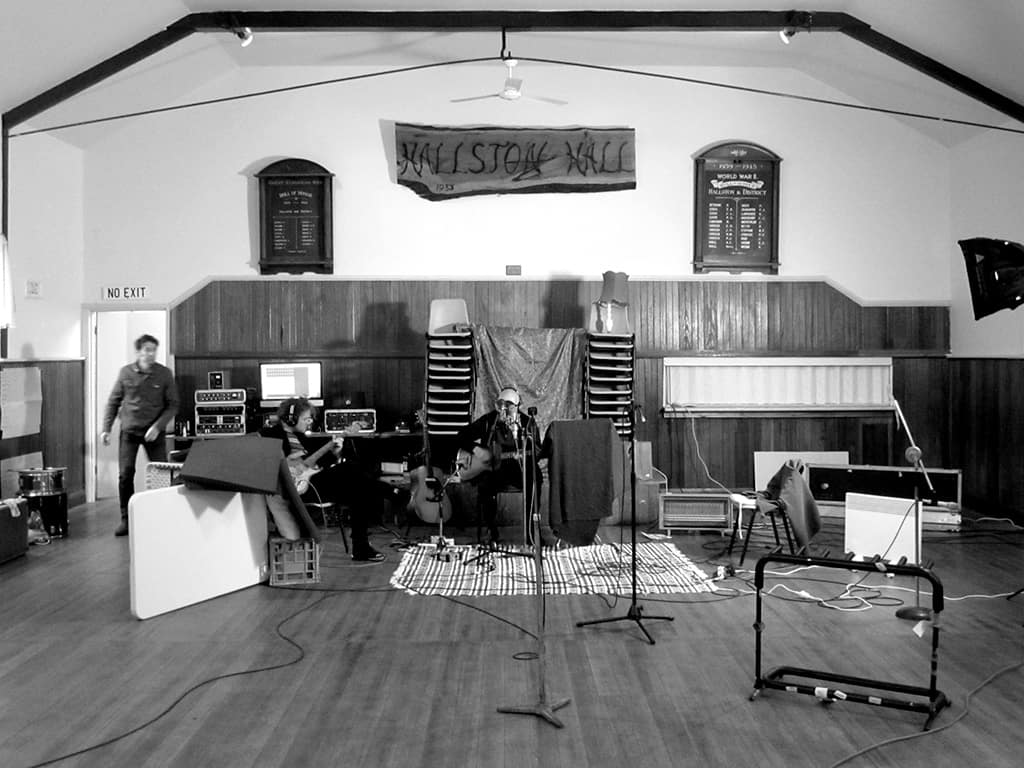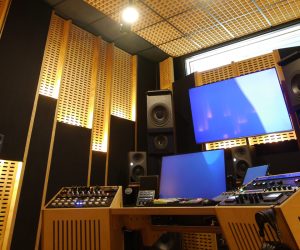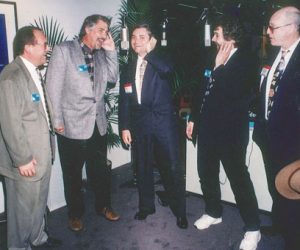
Kelly Country
Paul Kelly’s music is naturally Australian, so what better way to capture the icon’s latest record, Spring & Fall, than surrounded by natural country hall reverb.
Story: J. Walker
Photos: Andrew Doherty
When I got the call to work with Paul Kelly on a new record I felt really fortunate. I’d worked a little with Paul years ago, and had also done some co-writing and producing with Paul’s frequent collaborator and nephew Dan Kelly so I knew I was going to be working with quality people as well as (do I even need to write this?) amazing songwriters and musicians.
We talked a little about what kind of record Paul wanted to make and it soon became clear that he was after something pretty intimate and stripped back; less full-band arrangements, more space around the songs. Paul and Dan had just finished up touring in support of The A To Z Recordings and book — a catalogue of Paul’s songs performed alphabetically, often just with the two of them onstage — so they were really tuned in to each other musically and had developed a powerful sound with Paul playing rhythm on his beautiful old ’40s Martin acoustic and Dan playing more melodic riffs and solos on electric and acoustic guitars.
OUT OF THE STORM
We talked about the kind of acoustic-based records that had inspired us over the years, the kind of sounds we liked and the way the songs seemed to be heading stylistically. It seemed to me that this record didn’t want to be made in a conventional city studio. In the end we had it narrowed down to a couple of larger multi-use spaces we could rent in Melbourne, my studio in South Gippsland or one of my local country halls — there were a few I’d been using in recent years with good results.
On our first day of pre-production at my studio we were subjected to an almighty storm straight out of the Southern Ocean. Just after dark we had a blackout in the middle of a song followed by a minor flood in the studio which ‘put the dampeners’ on things at my place for the night. As the catastrophes mounted we happened to hit on just the right feel for one of the key songs on the record. I was playing along on double bass and Dan was weaving lovely arpeggios around Paul’s dobro guitar chords. We were excited enough by it that we kept jamming it out right through the blackout in the pitch darkness — we knew we were onto something good. My wife Karen somehow managed to keep the kids happy and cook us a roast by candlelight in the gas oven that night, and Paul and Dan went away damp but in good spirits. I meanwhile was wondering how we were going to go about recording a whole album down here in this wild place in the middle of a cold wet Victorian winter, especially if we ended up liking the sound of one particular hall (which I was secretly pinning my hopes on). We had another couple of days of pre-production booked so I figured we’d better do a dry run up at the hall and see how we went before making a final decision.

MAWSON HALL
I discovered Mawson Hall a couple of years ago when I made one of my rare C-grade appearances for the local tennis club in an away fixture and it’s become one of my favourite places in the world to record music. It ticks all the boxes — it’s back off the road a little, no close neighbours and the road itself is pretty quiet. It’s run by a very supportive local community who are happy to have acoustic music in there at a generous hire rate and it’s on top of the world with views of the lush South Gippsland hills in every direction.
It’s even got a well-equipped kitchen separate to the main room and a little library off to one side that works well as an amp booth. Most importantly of all it’s got clean 240V power and a beautiful big main room with a sweet, woody, darkish reverb that’s ideal for solo artists and acoustic combos to play in. My experience in this room is that artists come in a little unsure and leave with a big smile on their faces.
With this old-school approach it’s really important that the artist fully buys into the idea of live vocal takes because there will inevitably be imperfections, even when you cut between takes a fair bit. However, there’s a massive pay-off in terms of overall performance levels and atmospherics in what goes down. My other favourite thing about working this way is that after the first day everyone can listen back to the takes and hear what is basically the sound of the record — vocals, spill, ambience and all, not some carefully honed ‘bed tracks’ that you imagine will one day feel vibey and alive after you’ve spent days overdubbing and messing with them in the mix. It’s very immediate and the emphasis shifts from modern studio trickery back to the bedrock of songwriting, arrangement and performance. Of course, you need quality singers and players to pull off live takes but I had no concerns on that score.
PRE-PRODUCTION — A BAND IS BORN
Despite nervous looks at the weather forecast (rain on a tin roof sounds a lot like white noise) we got a good couple of days in up at Mawson Hall with no problems. One of our other main concerns was staying warm, but between our collection of bar and column heaters and the handy addition of ‘the rocket’ — a diesel-powered flame heater that sounds like a jet engine but heats the room up in about five minutes — we seemed to be able to play comfortably. I had decided to go the whole hog and rent, borrow and scrounge everything I thought I might need for the main sessions to come. I’ve always got a fair range of mics and preamps to bring along but I borrowed a few extra goodies from colleagues Cal Orr and
Andy Stewart.
As it turned out, our pre-production went extremely well and three of the four cuts we did over those two days ended up on the album (exactly what should happen in pre-production as far as I’m concerned). It’s great when you’re making the album before you even know you are, and a good reason to always set up for real. Paul and Dan fell in love with sound of the hall and we all really liked what we were hearing back. Contrary to what you might think, recording in a live space like a large country hall doesn’t mean you have to make a really reverb-drenched album. With all the room mics muted you can hear a lot of detailed, close articulations of the sounds but you can feel the warmth of the space that lies beyond the detail without being particularly aware of the hall reverb itself. Then of course when you wind the room mics back in, the whole thing opens up and becomes more ambient, but the important thing is that you can control it depending on the needs of each song.
The other thing that happened in those two days was that we started to really gel as a three-piece. I was (and still am) going through a bit of a double bass phase, and that instrument just seemed to sit right for this particular group of songs and the way the album needed to feel. When it worked right, the double bass played the role of bass and kick drum while the shortish decay of the notes left plenty of space open for the other instruments. At first I was a little concerned that I might be losing my producer’s focus by becoming part of the band, but that seemed to be the way the music wanted to flow and the others were into it. Dan felt that because I was pinning down the bass notes it freed him to concentrate more on melodic ideas, and it also added a bit of extra rhythmic propulsion to Paul’s powerful acoustic playing.
A real lesson in the art of musicians listening to each other, being patient, adjusting tones and parts until the magic started happening

BOMBS AWAY
The set-up for those two days ended up being our blueprint for the whole project and we didn’t deviate from those basic mic placements and signal chains too much. Not a lot of compression, plenty of room mic options and a fair bit of attention to detail regarding Paul’s vocal mics and Dan’s sounds and amp level in the hall. Once we’d got everything sounding sweet there wasn’t really that much to it and we could focus in on the song arrangements.
We seemed to fall into a pattern where we’d work a song for a few hours and get it to a particular stage, and then there’d be a shift. Dan would put his electric down and pick up a dobro, or Paul would switch from the Martin to a parlour guitar, or I’d put the bass down and grab a high-strung, Nashville-style guitar, and then the arrangement would suddenly come together and what had been sounding a bit average half an hour before, sounded fully realised.
It was funny how often this happened and it was a trick that kept working for us. I found the whole thing enormously satisfying and a real lesson in the art of musicians listening to each other, being patient, adjusting tones and parts until the magic started happening. The real luxury was that Paul, being such a consistently great singer, was willing to sing all day as long as we were making progress. While he was feeling out how to approach each song’s delivery (now and again tweaking lyrics on the fly) Dan and I were sorting the wheat from the chaff among the melodic and rhythmic ideas that were flying around the room. Dan is a consummate guitarist and made an art form of working up subtle delay and tremolo effects to wring memorable, character-drenched melodic lines out of his Gibson SG. He’s equally at home on a classical guitar or an organ too, and his arrangement skills and musicianship were central to the shaping of every track. He also possesses absolutely sensational cooking skills that quickly became mission critical.
ROLLING ON
The weeks rolled by quickly, a flurry of gear set-ups and pack-downs, ensemble recordings, careful listening sessions and edits between takes, excellent Kelly-cooked meals and kicks of footy out the front of the hall in the fading South Gippsland winter light. We set up for four days at Melbourne’s Head Gap studios where a superb roll call of guests came through the door; Dan and Peter Luscombe on keys and drums, Vika and Linda Bull singing fireside harmonies, Attila and Carolina Kuti adding violin, viola and cello and Laura Jean singing something between harmony and duet on some key songs. Before we knew it we were out the door, out of the city and back at the hall or my studio for more overdubs and evaluations of the songs. Some quality songs didn’t quite make the album because of it’s thematic nature — the whole thing is really the musical anatomy of a relationship in first bloom that then starts to drift before hitting rock bottom break-up terrain, and then there’s a bit of a recovery at the end. We were still debating the merits of certain songs when the mix began at Andy Stewart’s Mill studios down near the South Gippy beaches.


TANDEM MIXING
As I’d hoped, Andy came into the mix full of zest and fresh perspective after a holiday in California, and we were ready for the delicate task of mixing the record together on Andy’s 51 series Neve console. It can be quite tricky mixing with someone else, but Andy and I have done a few projects like this and we seem to have the knack of making it work. I generally lay out the song on the console and get it functioning as a basic mix after a few hours, then Andy takes over and hones in on key elements; the main vocal (Retro 176 compression, console EQ, lots of volume automation to keep the lyric front and centre), guitars (old Neve compressors, console EQ), bass (Calrec compressor, Retro valve EQ), and effects (Lexicon 480L and AKG spring reverbs). Eventually I’ll come back in and focus on some of the flavour elements like the backing vocals, string and piano overdubs, and then we’ll finish it off together, in this case with key input from Paul.
Another hidden bonus of working with another mixer was the bits of downtime that we both used to drive around the hills with Paul, evaluating mixes and testing out the tricky business of song sequencing. I even snuck in a couple of excellent surfs at the beach down the hill, and once we ended up at the local pub where we were invited to come down later for an old fashioned session. We went back late in the evening and there were about 20 older country folk all playing together, something they do every second Thursday apparently, all instrumental abilities welcome. We spent a couple of hours listening and joining in with a bunch of the most friendly country folks you’ll ever meet, all singing at the top of their voices and having a ball. Later they took photos of Paul and made him pour them beers at the bar. While this kind of thing doesn’t exactly advance the cause of the mixing, it’s pretty handy to walk into the studio with fresh ears after a couple of hours and hear what needs to be adjusted. At least that’s what we told ourselves….
NEW FOUND PERSPECTIVE
Back to the mix — for this album my new trick was to have an Al Smart compressor set up to parallel compress and ‘crush’ a few key acoustic elements such as acoustic guitars, percussion and BVs and then just ride a little of it in behind the main treatments. I also won the argument on which mix bus compressor to use, favouring the JLM Mac stereo pair over the Amek. Both are transparent (which is what we were after) but I like the sound of the JLM better and Andy sweetened up the mix with some high shelving Avalon valve EQ.
There was one song that wouldn’t quite come right. Predictably, it was the first song on the album, New Found Year, and critical to the whole song cycle to have it there. After much discussion Andy pulled out his drum kit and brushes and re-recorded the rhythmic elements at the Mill while Paul and I made one last dash up to Mawson Hall to do a fresh vocal and guitar take. When we put it all together the song worked much better and a lot of back-patting ensued. Dan agreed via email from London where he’s busy working on a new Dan Kelly record.
When the last mix was printed there was a palpable air of relief all round and we shared a quick drink before we all raced off to embark on other projects. Altogether the record took 17 days of tracking and 12 days of mixing — a pretty economical way to make an album and an absolute pleasure to be involved with from start to finish. Time will tell where it rates in Paul’s stellar recording career. It’s an album that’s been created to be experienced as an album — perhaps a rarer thing in this day and age — and it certainly isn’t geared towards any particular audience or radio station. It’s just a great collection of acoustic songs from one of our best songwriters. Time doesn’t stand still for Paul Kelly. He’s as curious about the world and as creatively committed and hard-working as ever, so it’s no surprise he’s effortlessly avoided the later career fadeouts of many a contemporary. As I write this he’s collaborating on an amazing spoken word performance event with modern classical composer James Ledger. Can’t wait to see what he does next.
















RESPONSES